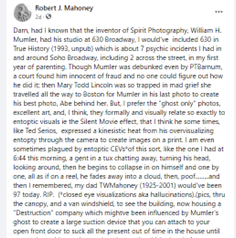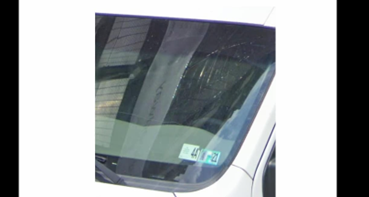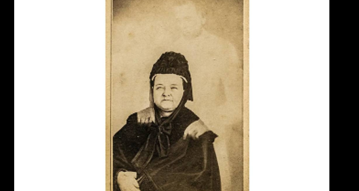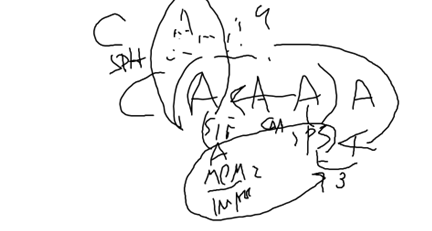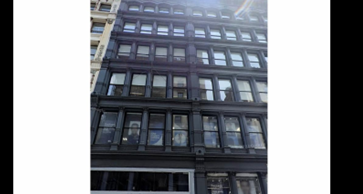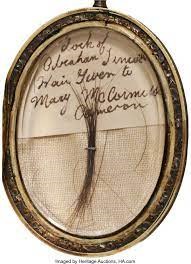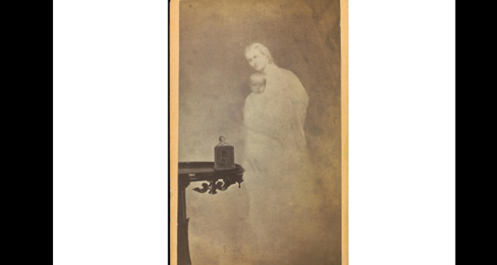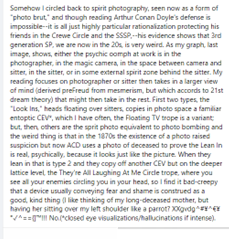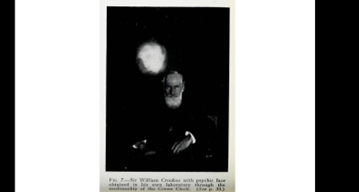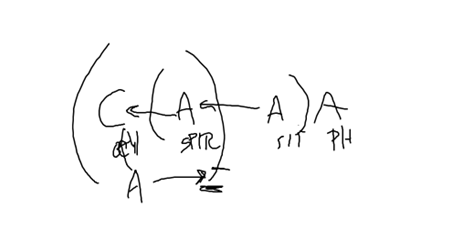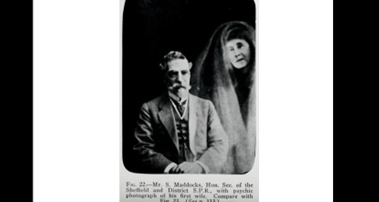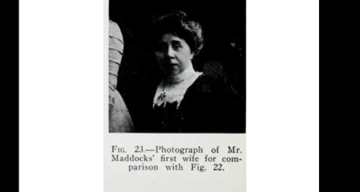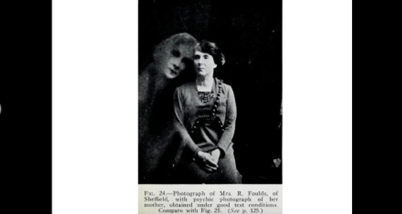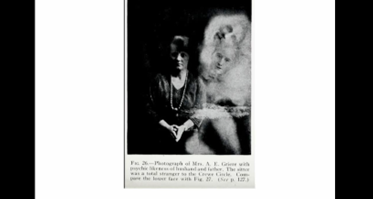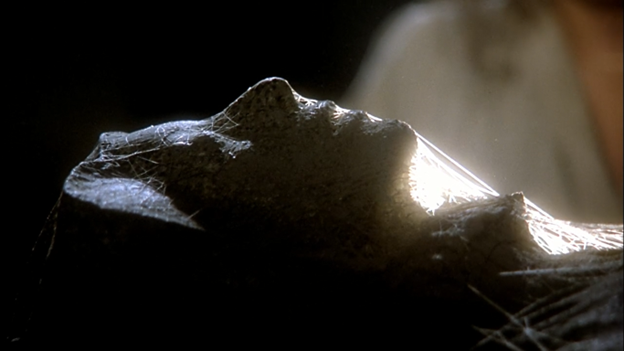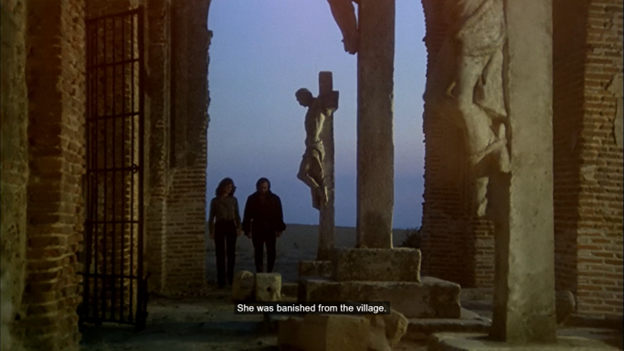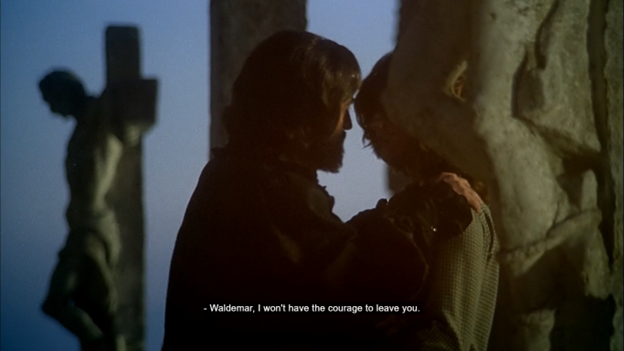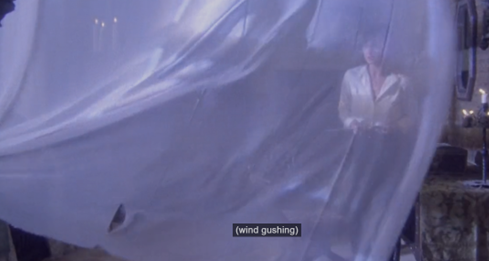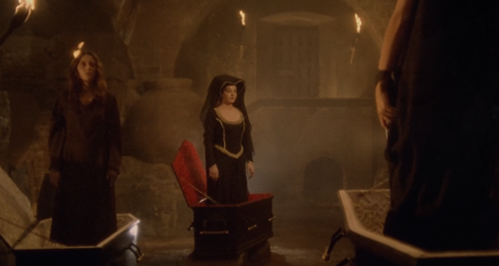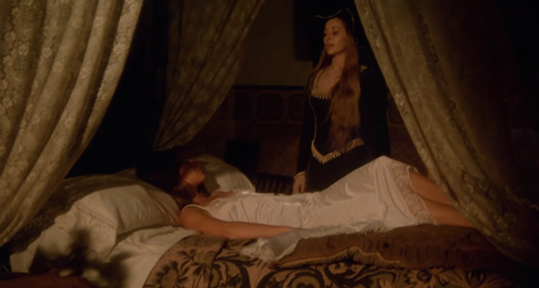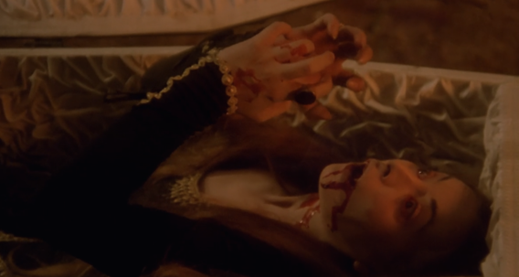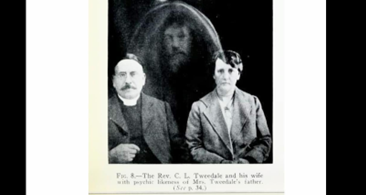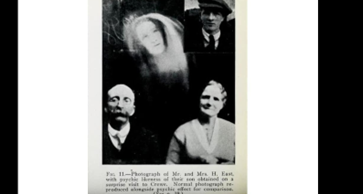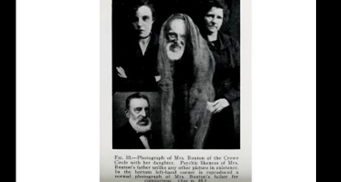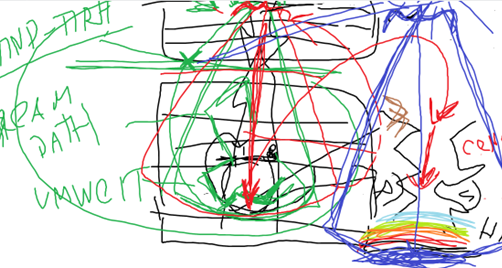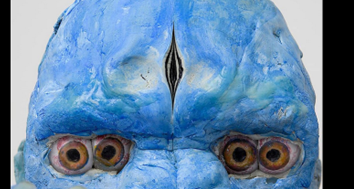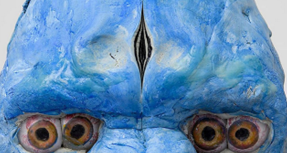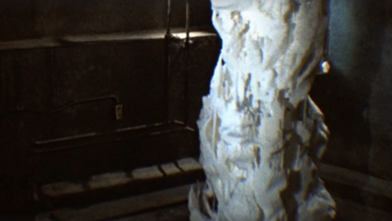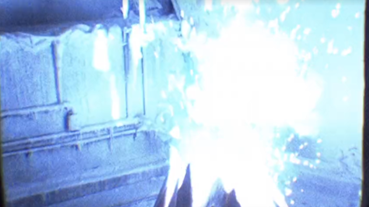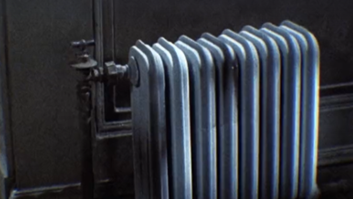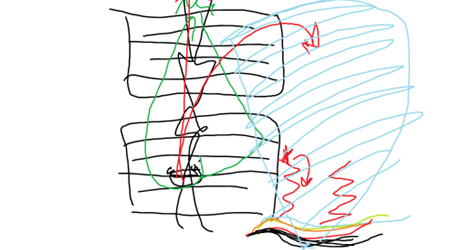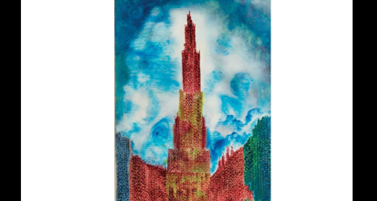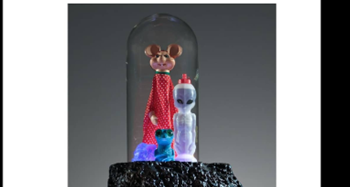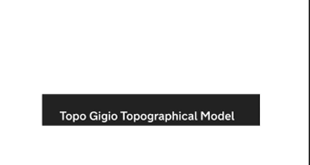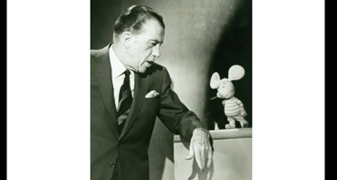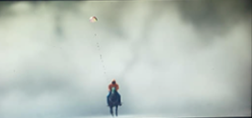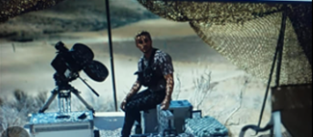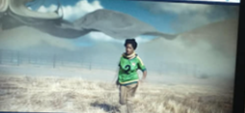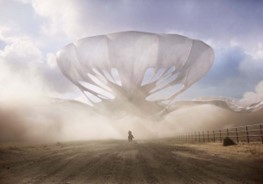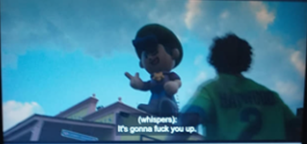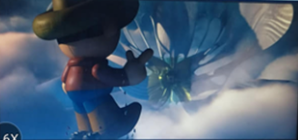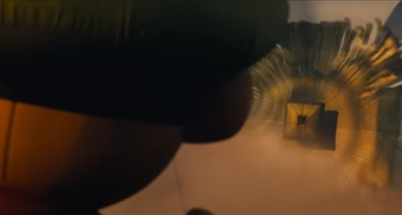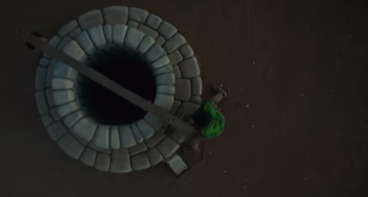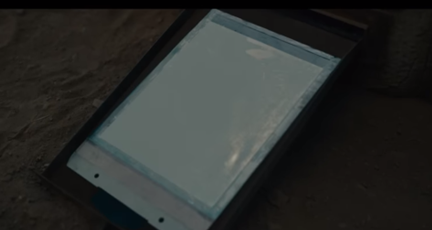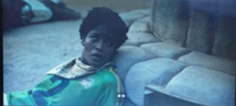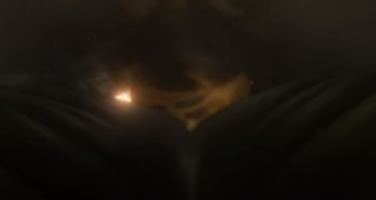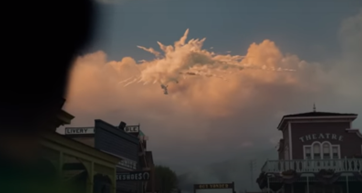Rev Oct 19,20, 21,22,25 2022.
It is by what I call le Fanu eye, the fourth way in which the spirit becomes physical, that the in-the-head dreaming can become the out-of-the-head spirit world. Generally stated, I believe that in the three-nightmare eldritch formation the first two nightmares occur inside the head, while it is only in the epigogic, or third nightmare, that one pops out of the head into ambient space, to see monsters.

but, in the presence or under the influence of a tychonic figure, a Man in Black, the equivalent to a mesmeric operator, and the overall appearance of these Crewe photos suggest its ever presence. It is also possible that even the syngogic nightmare bounces out under the pressure of the figure eight, to end up in ambient space.
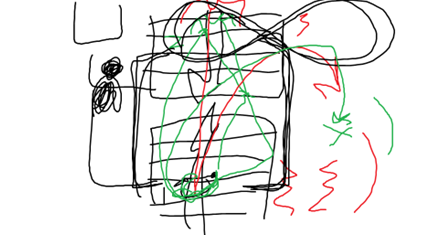
in this way, again by the ping-pong nature of the operator mind, this can lead to a strict binary division between the in-the-head, here and now, and the ambient spirit world, that is, the periacqueductal, depleted, haunted world IS, for the Crewe crew, the other side.
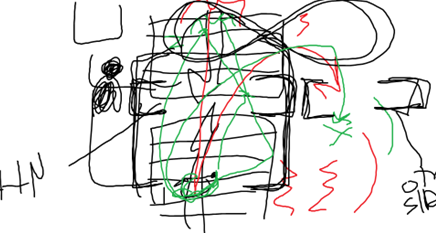
this tychonic-influenced distortion of light dream life, so typical too of the Eyes Wide Shut conceptualization of the dream world in modern life, pre 1980, means that, just as Burkert argues that Homer and the poets CREATED the mythology of ancient Greece, which only later came to be read as real; just as I argue that Stephen King CREATED the conception of town and national life that we now have, so too the Crewe circle created their own way of looking at the other side.
But, then, given the space in the photos, they also must have equated inside-the-head with inside the haunted house, and then the ghost living as if in the crawlspace behind or around in the ambient space beyond. Then they enlisted a convention that was even then descending upon the depiction of spirit space in ghost movies. That world came to be viewed as a world of veils, veils of ever decreasing materiality, getting sheerer and sheerer, in an mis en abyme, where you are not sure where you cross over, as the veils theoretically thin out to next to nothing. This appears in so many movies I need hardly work it out, it is ever present. So, when the veil appears, in Crewe photos, we are in ambient space, construed as the other side.
But, then, I mentioned in a post, the arch aspect of the veil. Very curious that Conan Doyle would call it an arch. There are two arches in my dream analysis, though this little wrinkle I have made less use of post 2020. This is when you enter into, by a retraction back to normal, but overcompensating of the Le Fanu Eye, the opisoentoptic space, or the space behind the eye, which then communicates with the mind, and leads one down in to deeper things. There ARE two gates there, the Heaven Gate, which is positive, and the Tannhauser Gate, and, it is true, I think Blake pictured these gates often, and his Antaeus lifting Dante down to hell, this is his rendition of the Tannhauser Gate (which I now see somewhat equates with the figure eight, lifting one down into the “moonfire” space of a “mondo”, that is, delusions in the mind, a false place). Both of these I equated with lifting the seen into a deep dream space below, to hell on earth. This more or less copies off of Platt’s construal of the layers of veils on Roman sarcophagi, allowing the mind of the grieving mother to waft back in to visit the deceased as long as the body remains remain there. Thus, the presence of the gate means that one is entering into this deeper state. It also means, because we are now dealing with behind the eye memories, a deeper, more beloved relative, held in a deeper place in the mind. The above posted comments were a periapt buy-in of the presence of Thala in the bottomless pit space, goddess of the inner chamber, the thalamus, as well as hippocampal places below. So, by the appearance of the arch, this photo goes deeper, with more feeling,
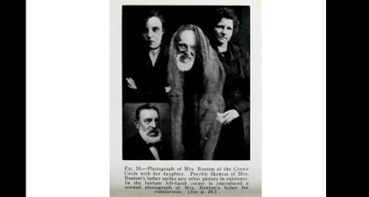
and, then, pictures where the veil arch or ectoplasmic arch only just appears as abstract wobble-wobble, this indicates two minds only just getting to the later stage in grief where they are able to move to that level and do that final grief work.

and then this one is slightly distorted, and not yet entirely fixed in place, because these two are a bit further along on the path, and only coming to settle the memory of the deceased in a deep place on the other side of the veiled arch, the Heaven Gate.

the added dimension of this form is that it copies exactly on the Roman visual tradition of the vellificatio. The vellificatio was a tossed up veiling device used in Roman pictures to indicate not just the presence of the supernatural, but the sudden appearance right this minute in the moment of the camera flash in the arrival of the supernatural, or a supernatural being. That is why gods and goddesses in Roman Sarcophagi appear furling a vellificatio behind them, they have been summonsed, and just like a genie, with his burst of smoke, so here too, the arch of veil indicates that the god, summonsed, has now appeared. It is all but an exclamation point, adding to the immediacy of the photo, which must have been doubly comforting to the sitter (who might at this point relay something like “you know I felt it, I felt her touch my shoulder, I am so grateful for that”).
But there is one more element to this visual convention. When the mind passes over the in-between, what I call the Luor, there is turbulence. If there is standard turbulence, it is just the wobble-wobble that signifies the passing over. By my reading, the vellificatio in Roman art, and the veil arch in dream art, represents the simple wobble-wobble. More turbulent forms are created by the arrival in advent of a switch from syngogy to epigogy of the CryBabyCry and the Savoy demons. And there is another kind of turbulence passing back out when the in-between is emptied out by the presence of a Tyche figure, and the wobble-wobble becomes an orontes form. But it does mean a crossing over. But, in this context, a different one too.
If the sitter is in the hypnagogic space of their own minds, and the spirit world as construed by the Crewe circle is in the crewsphere of the spirit world, in the crawlspace of ambience beyond, that means that in their black world a fear vector has switched to ON, as contact with that world was deemed generally scary to moderns, and that means that the face of the summonsed person takes on forms in accord with the out-in accordionizing of the figures on the fear vector
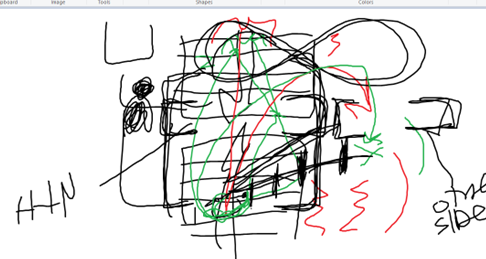
and in the various forms which the presences take on, they become involved in the flight of demons or angels in the fear vector, which, from another angle, brings into the picture skewographs of the spirits. I am having trouble incorporating a more skewographic dimension into my scirpographs. In my treatment of cattle mutilation, I called those construals of invisible presences to explain the mutilation by a nonobvious causation, “agoroskas”, sic, that is, plural, but also roving, aegis figures, presiding as an embrasure over the event, a delusion in moonfire space,
But in straight up skewographs a presence floats overhead and around, as in my treatment of January 6, Trump hovering over, comparable then to a hover dream too

then the Figment is a form of him seen as a pareidola in building and other ambient forms

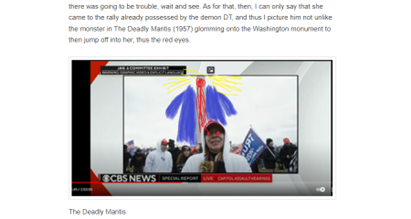
but then, when the breach occurs, a Famulus form forms, and this as it were spreads the body in body tunnel form out over and through the whole reality of it, to grant then freedom to move
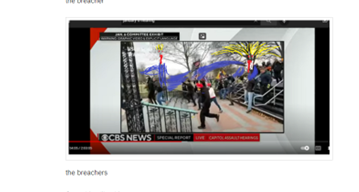
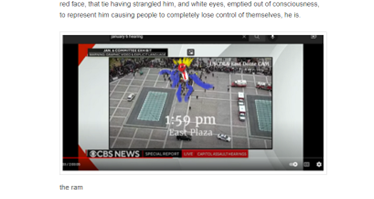
then the Conjure vector once again as if seeps into the building breached, to take it over first, very Gustonian level influx here.

and these parse as per the dynamics, the sleep demon having attacked, to the various figural forms of the psychomachia as I worked out in 2020
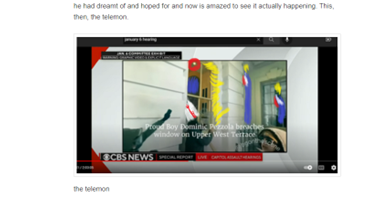

which is equivalent to possession, of form
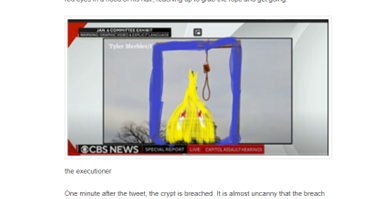
then, as I worked it out, after the attack began to deplete, things dropped down out of the fear vector, into the zone of the Green Dragon, into hell on earths, so various distorted forms there too

casting one out into sentient space
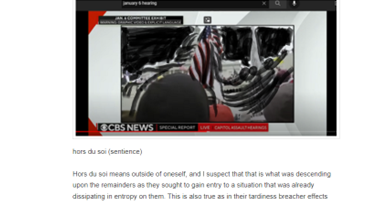
and, then, where I spend do much time of late, the bottomless pit

not in this-world nonfictional state did any of the skewerings of the demon form body tunnels make an appearance in anything found by the Crewe Circle. But it is true that the ectoplasmic arch might be construed as representing the self in a Figment form, and that (as I already know I will find in other pictures) others pursued more kinetic and dramatic ideas of the spirit movement around the sitter, to suggest also Famulus invasions (I expect to see however no demonic or existential “oothecan,” below the pit, manifestations in any real world spirit photo).
But this means a skewograph sees body tunnels or figurals at all the points of the fear vector, throughout the “under the bed” space psychomachia, and then spinning down and out into hell on earth, and below. I just mark in yellowlots of possibilities, in terms of human beings “seeing” figures in the mind and in dream

So, this one, its wipe-like or smear-like nature, it feels like a Figment, with a lot of captured movement.

and this one, because of the odd light up top left feels like the figure has rushed up into view to get into the camera range as if photo bombing the couple

and there is, especially, in the group of photos I analyzed taken directly from those chosen by Conan Doyle, this real life picture of a very beautiful young Brit circa 1920
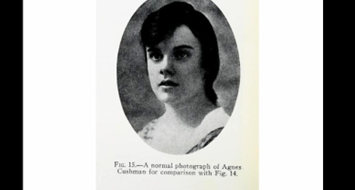
she emerges somehow as if on the tail end of a whisp of ectoplasmic veil sweeping through, a passing resemblance, gone as soon as snapped, very, very strange, I would call this a Figment having momentarily crossed over in, to make an appearance as a Famulus, to turn its eyes on you, and yet because it looks away (so not unlike the remark in The Innocents (1961), the ghost at the window is looking for someone else), creepy, but, again, the Crewe group, as far as I know now, stopped before any of this going where it always does in horror movies and ghost stories, to trouble

Indeed, after reading Conan Doyle, I turned to the catalog for the thorough show in 2005 at the Met, which I somehow was not able to get to, The Perfect Medium, and of the many, many, many images there, all of which must now be placed as per my system. I start with some which bring in more mobile body tunnel images to start.
In the Perfect Medium, Mumler is seen as a psychic, it is he who sees the ghost, and they work it out. But, then, in their history, the trend dies out in the US, and emerges in Europe in a different way. This can be indicated by this spirit photography of Frederick Hudson with Georgina Houghton

Houghton, of course, received some attention this past summer at the Milk of Dreams exhibit at the Venice Biennale, for her automatic drawings, which she thought were dictated by spirits. Reading her book, and even her daily ins and outs with spirit photography, the really crazy thing about her account is that she has, almost in the nature of a paranoiac, like Schreber, given away her personal agency to let the spirits make all her decisions, and they give her all her discoveries. In so far as Houghton believed all of this to come from outside her mind, this makes her nominable as a maker of genuine “foo.” Here is an early spirit photograph of her with her son and a ghost.

the odd thing about this photo is that it almost tilts the ground in reality over to the ghost side of the equation, as it is Houghton who fades into the background. Since she seems to have wanted her son to meet his grandmother, the fact that the ghosts drape twice touches him, in the same plane, at mouth

and toe

is problematic. But the real problem is all the drapery, It looks like a woman who has covered herself with all sorts of heavy drape and then stepped into the frame as a ghost. The fact that the drape below and above is extravagant beyond her needs if she were just toweling herself down after a bath, I suppose, is the vellificatio element that gives it its periacqueductal character of spirit, that is, wafts of spirit that somehow look like flowing cloth. (Though I don’t hear about the Psychic Arch until later, it is clear that that she intersected with and merged with that line of thought to resurrect another generation of ghosts in the 20th century). It is both a wobble-wobble creature, and a Famulus form, if the fear vector is ON. I assume that under the influence of the moment, in a séance etc, the situation shifts from vigilogogic to hypnagogic. The child is on the lattice, and, then, two things happen, the movement from waking to sleeping is captured in a vertical shimmy-shimmy, and then the lower drape almost like a risen up carpet to touch the table, with a suggestion, then, of animating the inanimate.

this posits that in the European tradition the spirit did not exist in a peripteral walled off ambient zone, but came in on the sitter on the lattice, on the fear vector, in the Famulus position. It rears up in front of them, then settles in down and around them, touching the child’s toe. Then, too, as the child is placed as a go-between between Georgina and the spirit this might’ve been staged by her to as a “picture-in-picture”, that is, symbol of her relation to spirits, to describe how it is the spirits dictated her drawings, by way of taking on the mind of a child, and she then records, not with holding the child, but with holding a pen, the appearance of the rearing up spirit
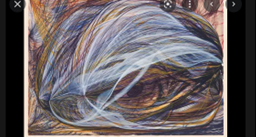
then it is swooping around,

then the space between her and the face of the spirit is all aflutter. She sees the face inside the ectoplasmic arch, the symbol of ghost, and it is intrusive and scary

then registering the child’s fear, falling back, she scribbles her opting out too

and it is in drawings like this, which strike one as her imagining what it is like inside the arch, it is in some relational posture to said spirit that she developed her line and style which as a “yrrhes!” (rrh=flow, remains silent) my term for the visual expression of a raw psychological sweet spot which in prototype space violates the norms of classic or accepted beauty in an artistic practice.
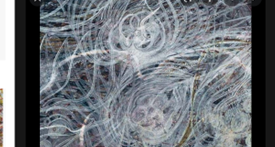
it is also true, based on this, she developed a relation with the spirit in which it took the form of the dynamic of the crossing over of the in-between, and simply as if by dictation she just scribbled away until the event or messaging ended. This one strikes me as getting a better look at the spirit of turbulence, almost the demon Savoy, in fact.
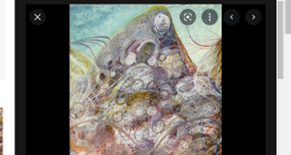
On the other end of the spectrum, in Europe, were séance-based photographs that only caught a blip of energy, in an abstract form. This is captured in letterspace inside the second symbolic level of vigiloogy, materialized as psychic light come in
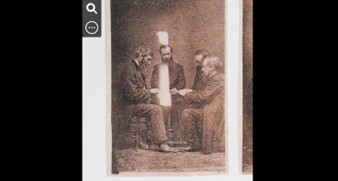
this idea, that the ghost is a figure of the crossing over itself, and seances and the like were primarily interested in describing the feeling of that crossing over, results in a mystified form of the simple wobble-wobble of falling asleep, but as if amplified by the emptying out of the here and now to be the divide between the psychological, hypnagogic, and the spiritual, conceived as being in the adjacent ambient space. In this photo by Hudson

the ghost is simply a figuration of the shimmy-shimmy of the nexus of the crossing over itself, a figurative fill=in of the psychic arch, where the psychopomp passed you over. And to add punch to the capturing of that moment, the man sleeps, and the energy of the space causes a levitation of a table, again, the step-in from the side involvement of a Famulus figure.
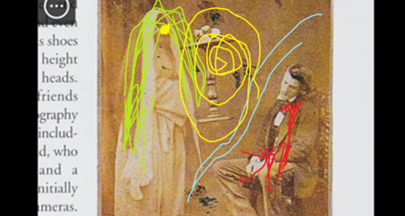
Scirpo, Famulus Spinning over the Luor, Hudson spirit photo 10 21 22
One of the theories of the time, going back to my original agency graph, believed in 5, and that in 5, spirits created spirit photographs by sending ghosts to the point of contact. Thus, these should be called photos by spirits. My above reading stays with point 3, the space between the photographer and the sitter is established in an externalized form, somehow, of the in-between, the space between waking and sleeping, and it is in this dream context that spirits manifest as the gap itself, and then come in on the sitter, and cause things like levitation, as a Famulus demon on the fear vector, in sleep.

given my argument that demons (of the mind) take on a psychodynamic form in shaping a dream, and as skewographs can even overcover perception of the real, in spins, spirals, etc– so in this I do practice a kind of abstract formalist form of spiritualism, viewed as only externalized dreaming–these are surprising, and yet entirely expected. What these photographs show are externalizations of people having various sorts of dream encounters with demons of the mind

I mean, if my graph of the “under the bed” psychomachia consists of a sleep demon, swirling around, moderated by the demon Telesphorus standing by, and then the rising up of a Blue Angel, these (even in sequence) would fit.
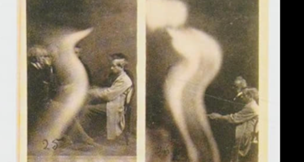
and then after the attack, this figure, left. is telesphorus, and the second one might be the Blue Angel,

the question then only being how did the seancer cause a group of men to drop into a dream and then experience a common dream form, transferred by Sleeper to them all, for it to then be photographed, in some way.
And, here is where I part company with the rationalism of the catalog forThe Perfect Medium. Its overriding goal seems to be to debunk spirit photography as fraud, and, for that, to relegate the entire genre to the ash heap of history. My approach is psychodynamic. That is, spirit photographs are works of art, enlisted in the overall mission of visualizing all states of human consciousness, as this would broaden human understanding of their own full nature. This is why I like dream-based and vision-based horror movies. I am interested in seeing consciousness stretched beyond the rationalist norm. The only problem question for me is why, why did those seeking “foo”, that is, the beyond, feel it necessary to declare their articulation of such things as REAL, in real space and time, and not as works of art. Ostension and reverse agency would theoretically describe this, the Sleeper phenomenon might explain it in terms of groupthink hypnosis, Why? Why the insistence on reality, and why? Why when you look at “foo” photos (and this of course hold for UFO photos too), even if you know it is obviously fake, how come it keeps refluxing so that after you look at it knowing it is fake it still somehow still looks real. And that would be in the yrrhes! which characterized a prototype zone contact with a real thing, of some sort, and it being not art or “brut art”. (I look into Emma Deane’s freak marks and her foray into thoughtography later)
In the catalog for The Perfect Medium it is claimed that interest in first generation spirit photography died in the UK due to the bad publicity of the Paris trial where it was discerned that all spirit photographs were simply tricks, that is, double exposures, and not evidence of real contact with spirits from the spirit world, or as envisioned in the minds of the sitters etc. To me, this is beside the point, as either way, a classic spirit photograph evinces a belief that spirits hover close to us, and this gives us comfort. And, again, it may be an element of the redressed imagination, something declared not real by the primary imagination, resurrects in a sequel over and over again.
I noted in support of hollow earth theory that the theory might’ve been believed in by some whose mind remained stuck in the extreme phenomenology of the childlike mind. The theory helped believers maintain as if a relation to life as an embryo in the womb to her mother, without any gap or rationalization, but totally self-safety. Cindy Hendershot in her book on paranoia in 1950s sci fi argues that advances in science precipitate as paranoia in modern men and women, a radial cult view would forestall that. The same thing could be said for this picture by Hudson of Alfred Wallce and his mother. Here is an old man (I once wrote a long paper on Wallace’s theories as they applied to Conrad), who still feels the presence of his mother hovering over him, even to the point of her realm closing around him on all sides. She is now in front of him, almost on his lap, and in this the psychic arch represents the crossing down to a deeper level of mind, and then the mother is there in the form of a cut out form portrait of the mother (this device intended to convey the idea that in periacqueductal spirit space things are less material, and her skin is indeed closer to fabric than to skin or beard).
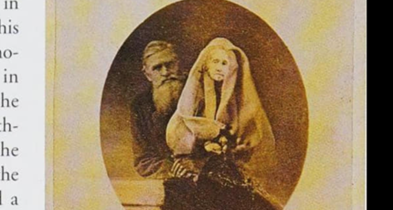
This is Wallace, a naturalist, he has seen monsters, and nature in its monstrous form. His dream world, it would have advanced to the epigogic, if not the cosmogogic level, and he gets there by way of the Tannhauser Gate, Antaeus lowers him in. It has also fused into one conception in his mind behind a peripteral wall, where, deep down, she is placed, but maybe he worries that she suffers, on the place of sacrifice, and he wants to know, is she ok? And so the photographer comes in over the top of him as the tyche figure with his own rhabdom, that is, the camera, and either as psychic, 1, or in the manifestation of the space between 3, his 5, he sees her hover around him, 4, and that sums it all up, she takes the acqueductal less-materialized form, and he is happy. This is like a spirit photograph valentine to a core primitive mind that had to, to feel safe in life, know that his mother was ok. Like this,
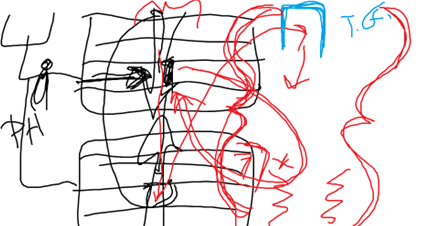
like this

scirpo Alfred Wallace Rescues his mother from beyond the Tannhauser Gate, Hudson photo, 10 21 22
And the more “body tunnel” Blakean skewograph formation of it.
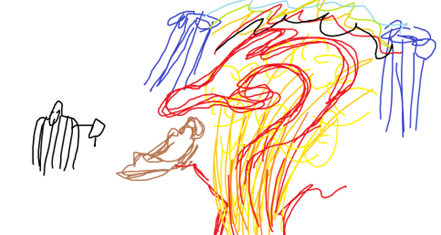
scirpo skewo, Alfred Wallace reunited with his mother, Hudson, 10 21 22
And, of course, once Hudson accepts the Psychic Arch as a form that precipitates into a cloth-manifest ghost, that ghost can like a skewograph dream of it, pivot any which way relative to the subject, spiraling as it is, in their conception of the spirit world as 5, behind, but also 3, in the space between, and seen by 1 and 5, to be real.
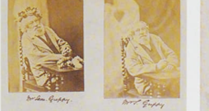
In these photos, the spirit space becomes 3, that is, exists in between camera and sitter, and camera 2 peers through it, perhaps fueled by 1, psychic photographer power, but the upshot is it sees a spirit now as a fusion of cloth, paper, 2-d, and the periaqueductal, and it like a skewograph interacts with the sitter in dramatic ways.
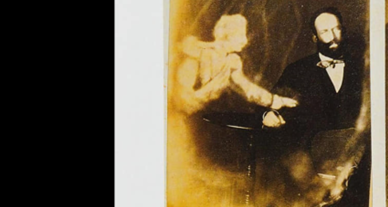
This one is fun because it imagines a Famulus demon having got into the hoop skirt of the sitter for then the ghost to manifest as almost a UFO of hoop skirt, with the light coming up out of her upskirt universe (again the pulse of frustrated sexual power in these photos makes them oddly erotic), and it is mano a mano,

something like this

scirpo Battle of the Hoop Skirt ghosts, Perfect Medium, 10 21 22
Then, from this photographer, having “reduced” the ghost to a light element it can travel in syngogy, searching, passing by or over, momentarily caught in its wanderings
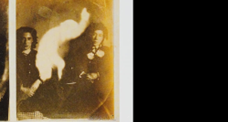
or, indeed, in the fields where in the second eldritch formation nightmare, one searches for talismans, one can see a wandering soul, lost, unable to find his way. This might’ve, I imagine, caused the sitter some pain, to think of one’s loved one lost in the afterlife.

These all come from, I think, the William Pierce album, from various photographers, produced at such volume that it is clear that an occult theory had folded over onto the practice to allow of a large scale expression of possibilities without worrying overly much about whether or not they are literally in our world real It is the general belief in our day that Democrats are all educated rationalists and it is only uneducated Trumpers who adhere to conspiracy theories, but in fact personalized confabulations of bits and pieces of theory compose the minds of pretty much all people on planet earth, giving or taking amongst the options. And so, this is first generation spirit photograph in its decadent maturity where concerns over fraud were set aside (indeed, after being convicted of fraud the Parisian photographers Buguet did his time, then, when he got out, simply changed the framework of conception of his work, to call them entertainments, made for fun and amusement, and went right back into the proto-movie spirit photography business).
But, in terms of the Pierce album, things, suddenly, become alarming, strange.
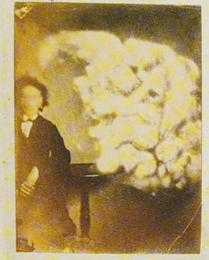
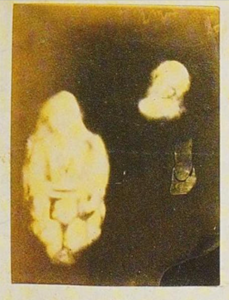
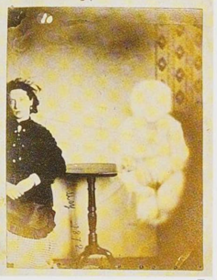
There are two phases here, pure miasmic ectoplasmic world, and then it settling into light forms coming forward out of it. The first group are alarmingly strange. They look like a large cloud of intestines come surging in the photo toward the sitter, who is oblivious. How to construe this? In second generation spirit photography, European version (though it spread to America at that point too), ectoplasm was imagined as a physical substance manifesting of spirit or energy in a person. In the Middle Ages, spirit was part of anatomy. Inside of one, harboring one’s heart, was a soul. That soul was made of as if a mist, the source of gas, perhaps, but a “spiritus” flowing through a spiritual body. It was that body, the soul body, the corposant, that escapes or just left the body upon death. In modern life, spiritus was reconceptualized parallel to discoveries of the entrails of humans. Thus, it looked like puke, and spit, and blood, and intestines, and gas, but all of that in a spirit form (transcendently outlining the physical). But then if you believed in 5, that is, that a spirit photograph rather shows the entry of the spirit world into this world, behind or beside the sitter, while it is true that that world could send ghosts over, if that world is in whole conceptualized as a miasmic melee, as nothing but a cloud of miasmic guts, then it in its pure form could spill over as spirit guts into the space of the sitter and be photographed. It logically follows from ectoplasm leaking like snot from noses or vomit from mouths or blood or cum from pussies under tables, that that whole ectoplasmic universe could cross over. In this picture, then, the sitter becomes as subject of the Antaeus figure at the Tannhauser gate, which is the photo, and we get a scrying sight of the very entrails of an entrailed world of ectoplasmia, Antaeus=ectoplasmia (and this obviously relates to some of the more extreme body horror movies made, I think of Society (1989)). Since this is a bodied form of miasma, I place this in fourth layer Hell on Earth, Mulciberium. Since this is a vision of the camera or photographer, I also see it as a mondo, a delusion, not constitutional to the world or the self.

Indeed, this glimpse into deep spirit world would be inherited by blood and guts display in horror movies, such as in The Lorelei’s Grasp (1973), where heart removal is seen as critical to understanding the perverse appetite of the Lorelei. Something like this

Ectoplasmia Encroaching on a Sitter, Pierce Album, Perfect Medium 10 21 22
And, again, the secret charge in this sort of thing is that we remain in the pre-endoscopic period of time, that is, except for anatomizing and autopsy, there is no way for the average bloke to imagine these realms of intestinal spirit without having to go through the surface of the nude body, even of women of this age. It casts upon these strange visualizations a very superrepressed aura of sexual perversion. Indeed, I made requisite jokes of how the ectoplasmic played out in the second generation, after Rontgen had discovered real endoscopic sight of the internal body.

“Now, I’ve gone and done it, bumped into the catalog for the exhausting 2005 Met show on photography and the occult, The Perfect Medium (2005), and it is stuffed with crazy pictures of ectoplasm leaking from the most unfortunate places and orifices, aura, magic “od” fluid and other occult captures, all of which I will have to sort through (I see them as waking dreams, with a catch). Indeed, one fellow in the 1890s claims that by putting a treated plate to his wife’s forehead while sleeping it snapped a photo of her dream, an invention I still eagerly await. But it was not all fantasy, that ring on a skeleton’s hand is actually Berta Rontgen’s hand, x-rayed by her husband, December 22, 1895, the world’s first x-ray, launching humanity upon the endoscopic era. (pics, random selection, ectoplasms, Louis Darget, dream photo, the Rontgen x-ray, 1895)”

and this was, I concede, a joke on the unspoken nature of Liz Truss’ womanhood, as oozing ectoplasma as she imploded as a leader in six weeks, out of this podium, to momentarily return to the level of discourse of critique that dominated the Trump era
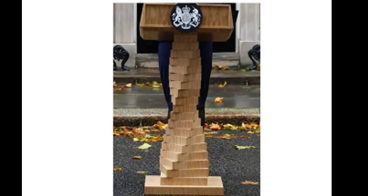
Then here the ectoplasm leaking from a vagina

and a mouth (I have been over these previously, but now have to figure them in in terms of the whole of the dreaming but later)
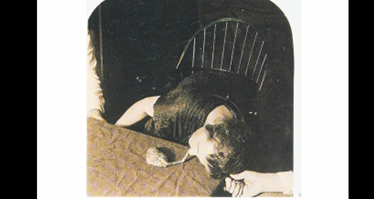
and then the image that ushered in the endoscopic age

I should also say this field of vision is friendly to multiple pareidolia sightings, I see at least five, and that then would give license to further envisionings, a popular thing, in a topic of representation that even came up this past month involving the realistic nature of the depiction of Marilyn Monroe talking to her unborn baby, the silly rationalists protested, in Blonde (2022). But this gives rise to sightings of a baby, maybe a baby that miscarried, or died, here next to an old man.

and this truly horror story frightening vision of a ectoplasmic baby floating in the air of a cramped little evil-wallpapered bedroom in Crewe or wherever, haunting a woman who maybe had an abortion, the Blonde (2022) plot.
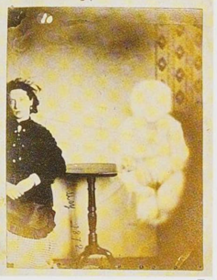
and this was someone’s calling card, or shtick, see your dead baby in limbo1
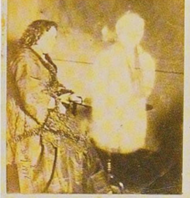
then having Dickens’ description of the souls that no longer can influence us, we then step on to a further figuralization, active attempts by spirits to gesture at the sitters, seeking intercession.
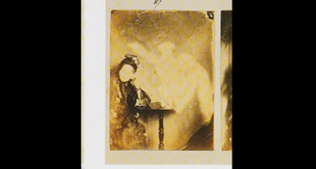
and this crazy one almost reaching down into the room to pluck the sitter out, back into the ectoplasmic spirit world

which finally just become ghost storying, with no relation to “reality”

A variant on this is if the spirit world is envisioned as a mirror world of ours, where, that is, the spirit side of us exists simultaneously to the body side of us, and I have construed “sequituras” as exactly this ransom paid for eight alone minutes in a womb in the existence of a spirit version of oneself, held as if collateral in the spirit world beyond (but which can only exist in the human mind, as I construe it by these studies this far, in a figure eight oltre-eschelture formation, that is, under the influence of a tyche figure), then there is a double of you in the spirit world which you might be able to make contact with and thus somehow regulate or get answers about uncertainties in your life. This gets into the scrying of real ghosts that seem attached to places or persons in a mirroring way, this…to be continued

this double world was the subject of interest of Allan Kardec, who had a name for it. He argued that thought could activate that world, causing the substance of it to as if take a photo of itself. He called it the PERISPRITAL.

he believed that in photographer 1 or sitter 4, in the in between space 3, thought created an intermediary form of energy, “fluidic images”, these are then reflected in the spirit world, imagined as a PERISPRITAL envelope (this very much like my idea of the peripteral nature of ambient form imaginings), and this envelope is as if, vis a vis the real, a mirror, where it becomes in reflection embodied, the element then to as if take a picture of itself. Thus comes into it cameraless spirit photography that only requires the pressure of the medium’s hands on the plate, or the zap of the medium’s mind in thoughtography onto the plate, to form an image.
End of pt. 2.
